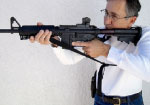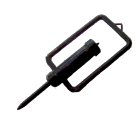By Marek Pruszewicz
BBC World Service

John Singer Sargent was commissioned as a war artist in 1918
The first major gas attack in war occurred 100 years ago this weekend, in what is now Poland. Gas soon became a routine feature of trench warfare, horrifying soldiers more than any conventional weapon. But was it actually as deadly as its terrible reputation suggests?
As he climbed to the top of the church belfry in Bolimow, west of Warsaw, General Max Hoffman of Germany's Ninth Army was expecting a bird's-eye view of a military breakthrough - and a new chapter in warfare.
The date was 31 January 1915, and he was about to witness the first major gas attack in history.
Gen Hoffman watched as 18,000 gas shells rained down on the Russian lines, each one filled with the chemical xylyl bromide, an early form of tear gas. But the results left him disappointed.
"Gas had an image problem from the start”
Jeremy Paxman
"I had expected much greater results from the employment of this ammunition in - as we then imagined - such large quantities. That the chief effect of the gas was destroyed by great cold was not known at that time."
But the failure at Bolimow proved to be only a temporary setback. By April, German chemists had tested a method of releasing chlorine gas from pressurised cylinders and thousands of French Algerian troops were smothered in a ghostly green cloud of chlorine at the second Battle of Ypres. With no protection, many died from the agonies of suffocation.
Within a few days, the Daily Mail published an editorial lambasting "the cold-blooded deployment of every device of modern science" by the Germans.

The Daily Mirror joined in the condemnation of gas - three months before Britain used it against German troops
The commander of British Expeditionary Force, Sir John French, called the use of gas "a cynical and barbarous disregard of the well-known usages of civilised war".
But four months later Britain itself attacked the German trenches with gas, at the Battle of Loos."Owing to the repeated use by the enemy of asphy iating gases in their attacks on our positions, I have been compelled to resort to similar methods," Sir John explained. There were commanders on both sides who felt uncomfortable about this new weapon.

"I fear it will produce a tremendous scandal in the world... war has nothing to do with chivalry any more. The higher civilisation rises, the viler man becomes," wrote Gen Karl von Einem, commander of the German Third Army in France.
On the British side, Lt Gen Charles Ferguson noted that Britain had not been the first to use gas, but still dismissed it as "a cowardly form of warfare".
And even while Germany and Britain and France strove to develop new and more effective gases, it continued to be thought of as a "dirty weapon" says the broadcaster Jeremy Paxman, author of Britain's Great War.
"There was something much more soldierly about a sword or a gun. Gas had an image problem from the start."
It also had a profound psychological impact on soldiers - it terrified them.
"When the 'gas alert' gongs were first sounded I suddenly remembered amongst other things which [flash] through one's mind at such a time, that Henry V before the Battle of Agincourt knelt down and prayed…this is exactly what I did," wrote Captain E E Simeons in December 1915.
Prof Edgar Jones of the King's Centre for Military Health Research in London has found numerous examples where the fear of gas spread like a virus.
In September 1915, Lieutenant G L Grant, a medical officer of the London Scottish, had to deal with large numbers of officers and men who thought they had been gassed, but displayed no physical symptoms. He "cured" each of them with a placebo.
In February 1918 one soldier of the 1/22nd London Regiment developed a sore throat and reported that he had been gassed. Although there had been no reports of  a gas attack, panic spread - and within hours, 67 of the 105 men in the unit had been evacuated as gas casualties.
a gas attack, panic spread - and within hours, 67 of the 105 men in the unit had been evacuated as gas casualties.
"I think its scary science, the thought that it gets into your system and you can't really see it, unlike a piece of shrapnel or a bayonet wound," says Jones.
Ian Kikuchi, a historian at the Imperial War Museum in London also sees something insidious about gas.
"Gas, which moves like a vapour, brings to mind ghosts, phantoms and other things associated with death," he says.
"I also think it has something to do with gas masks themselves - to protect yourself from the gas you have to make yourself look and sound frightening."
It is this particular horror of gas that is captured in Wilfred Owen's poem Dulce et Decorum Est, arguably the most widely read description of the horrors of war in the English language.
In all my dreams, before my helpless sight,
He plunges at me, guttering, choking, drowning.
The poem is written in the style of a first-hand account, but there's no evidence in Owen's letters from the front, or in his regiment's war diary, that he experienced such an attack before writing the poem.

"He could have seen an attack, we don't know, or he could have heard an account second-hand from soldiers, or it could just be imagination," says Oxford University's Dr Stuart Lee.
Owen describes a chlorine attack, referring twice to the gas's characteristic green colour - and victims of a chlorine attack would indeed choke. The gas reacts quickly with water in the airways to form hydrochloric acid, swelling and blocking lung tissue, and causing suffocation.
But by 1917, when Owen went to the front, chlorine was no longer being used alone. Another, more dangerous "irritant", phosgene, was the main killer. But phosgene is slow to act - victims may not develop any symptoms for hours or even days - so Owen's description may not quite fit with the reality of gas attacks at that moment in time.
The standard-issue gas mask in 1917 - the "small box respirator" - provided good protection against chlorine and phosgene.
But soon all sides had turned to gases which maimed even soldiers wearing a mask - blistering agents, or "vesicants".
The most widely used, mustard gas, could kill by blistering the lungs and throat if inhaled in large quantities. Its effect on masked soldiers, however, was to produce terrible blisters all over the body as it soaked into their woollen uniforms. Contaminated uniforms had to be stripped off as fast as possible and washed - not exactly easy for men under attack on the front line.

A horror of the use of poisonous substances in war goes back far beyond WW1.
The first bilateral treaty banning the use of chemical weapons - poisoned bullets in this case - was signed in 1675 between France and the Holy Rome Empire, says Dr Joanna Kidd of Kings College London.
"There's an argument that humans have always had revulsion to using poison in warfare," she says. "I suppose there are ways we are just accustomed to being killed."
The Hague Convention of 1899 outlawed shells for the "diffusion of asphyxiating or deleterious gases" even before they had been used on the battlefield. (The very first use of gas, in the form of grenades rather than shells, is thought to have been carried out by the French in 1914 - the attack was so ineffectual that few even knew it had taken place until the war was over.)
But even in World War One there were those who argued gas was no worse than other weapons.
"I cannot see the difference between killing a man with a chemical substance and rending him to pieces with high explosives. The first-named form of death, as a matter of fact, is the most merciful," wrote one Dr J F Elliott to his local paper in 1915.
Other terrible weapons were developed at the same time. The flamethrower appear on the Western Front in 1915, two months before gas. Others weapons, like the machine gun, were honed to new levels of murderous perfection. The biggest killer of all was artillery. Yet it was only the use of all gas that was outlawed by the Geneva Protocol of 1925.
Exactly why gas was singled out is disputed. The Protocol itself makes the lofty statement that gas "has been justly condemned by the general opinion of the civilised world".
But the only reason countries were prepared to ban it, some argue, is that it was ineffective.
Gassed
 John Singer Sargent's painting of a line of blinded soldiers came to be known by a one word title: "Gassed."
John Singer Sargent's painting of a line of blinded soldiers came to be known by a one word title: "Gassed."
It appears today to be a visual condemnation of the horrors of gas warfare. However, Richard Slocombe, Senior Curator of Art at the Imperial War Museum, which holds the painting, explains Sargent had a different intention.
"The painting was meant to convey a message that the war had been worth it and had led to a better tomorrow, a greater cause, that it had not been a terrible waste of life," he says.
"It is a painting imbued with symbolism. The temporary blindness was a metaphor, a semi-religious purgatory for British youth on the way to resurrection. You can see the guy-ropes of a field hospital tent depicted, and the men are being led towards it."
Casualty figures do seem on the face of it, to back up the idea that gas was less deadly than the soldiers' fear of it might suggest.
The total number of British and Empire war deaths caused by gas, according to the Imperial War Museum, was about 6,000 - less than a third of the fatalities suffered by the British on the first day of the Battle of the Somme in 1916. Of the 90,000 soldiers killed by gas on all sides, more than half were Russian, many of whom may not even have been equipped with masks.
"In a war of attrition morale is critical and this was an attempt to undermine morale”
Prof Edgar JonesKing's Centre for Military Health Research
Far more soldiers were injured. Some 185,000 British and Empire service personnel were classed as gas casualties - 175,000 of those in the last two years of the war as mustard gas came into use. The overwhelming majority though went on to make good recoveries.
According to the Imperial War Museum, of the roughly 600,000 disability pensions still being paid to British servicemen by 1929, only 1% were being given to those classed as victims of gas.
"There's also an element of gas not showing itself to be decisive, so it's easier to... not have to worry about the expense of training and protection against it - it's just easier if people agree to ban it," says Ian Kikuchi.
But Edgar Jones disagrees. By the summer of 1917 gas was inflicting a significant number of casualties, he argues, removing men from the battlefield for six to eight weeks, tying-up beds and nurses, and using up valuable resources. And it was effective as a psychological weapon too, he says.
"In a war of attrition morale is critical and this was an attempt to undermine morale."
In the final analysis, Jones says, it was banned because it was "not quite cricket". Jeremy Paxman sees both factors in play - primarily it was revulsion, he suggests, but also it was accepted that gas had not lived up to expectations.
"The reason it was banned is because it had been a particularly grotesque weapon. Geneva was an attempt to civilise war," he says."Gas had not worked - and it was considered unsoldierly."
Is Dulce et Decorum Est autobiographical?
Wilfred Owen was at the front as a lieutenant with the Second Battalion, the Manchester Regiment, from January to May 1917, when he was knocked out by an explosion and diagnosed with shell shock. He wrote frequently and graphically to his mother, Susan, about what he witnessed.
"Owen generally didn't hold back in describing what was happening to him at the front. In one letter to his mother he tells her he isn't just at the front, but `in front of the front` in no man's land," says Dr Stuart Lee.
So did Owen write to anyone about the kind of attack depicted in Dulce?"No is the answer, and it's one of the great mysteries. In one letter to his mother he mentions being slightly affected by a tear gas shell, but that's the only reference and the only mention of a gas attack of any kind," says Lee.
The official war diary of the 2nd Battalion, The Manchesters has no reference to any gas attack in the period Owen was at the front line in 1917. The basis for his most famous poem remains a mystery.
Owen returned to the front in August 1918, and does mention gas attacks at least three times in letters written in October 1918 - but that was a year after he wrote Dulce et Decorum Est.





